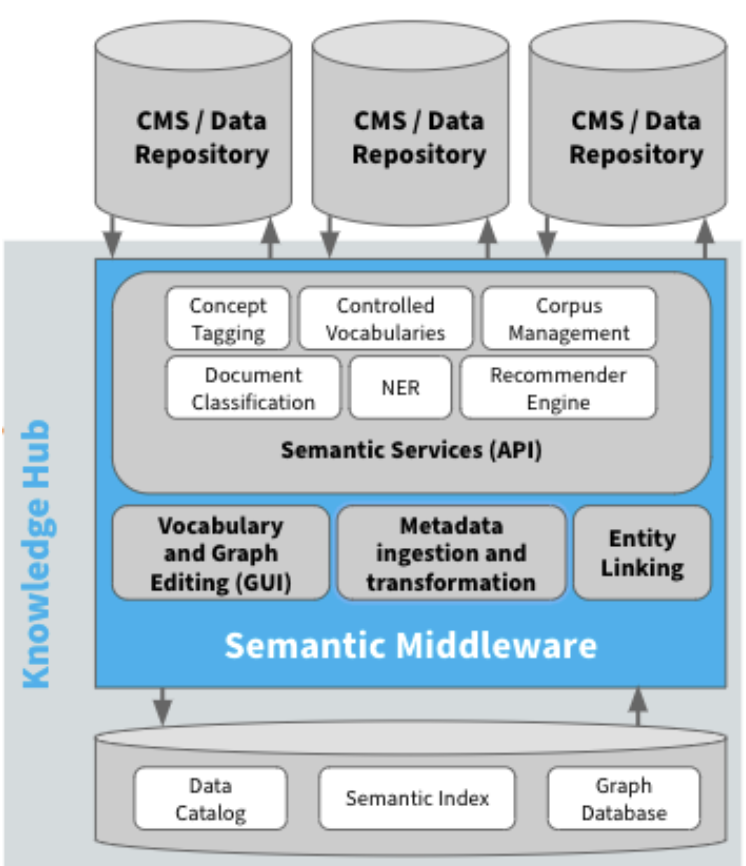
For many companies, while content management systems and digital libraries get the job done in terms of storing documents, legacy systems often lack the ability to make documents “actionable” – which is to say that data and content are not discoverable, networkable nor reusable.
Legacy CMS are limited by “bare-bone” capabilities such as:
Intelligent content hubs are the natural progression from a standard CMS or user portal. They go beyond a simple curation and maintenance of business assets, and add a much needed layer of intelligent search and recommendations. They combine multi-source systems (without necessarily removing and replacing them), leveraging the strengths of each of them in an ecosystem powered by Semantic AI.
To lessen the burden on internal stakeholders, the first thing that needs to be achieved is making content more accessible. While this applies to various roles in a company, let’s take a look at two roles simplified to a “content producer” and a “data gatherer.”
For content developers a.k.a the producer…
It’s important for content writers to be able to collect company documents for research before they begin writing. A writer should be able to enter terms in a search field about a topic e.g. “content hub,” and be given multiple results based on the metadata attached to the documents. A basic search powered by basic metadata will only return results tagged with those exact keywords (content hub), whereas a semantic search powered by enriched concept-based metadata will retrieve documents tagged with all its synonyms or even closely related terms: intelligent content hub, knowledge hub, content management, enterprise knowledge graph, etc.
The danger of the basic search is that maybe a crucial document does not turn up because it was not tagged with the word “content hub,” even though the content itself is very relevant to the user’s search.
For consultants a.k.a the data gatherer…
A sister to the content hub, a knowledge hub houses unstructured data (text documents) and structured data (Excel/CSV) to form an index of all the relevant information stored in various systems and formats. An enterprise knowledge graph, which serves as a building block of an internal knowledge hub, helps employees anticipate challenges by having a detailed, dynamic overview of all their information and recommend the best next action items in real-time.
An account manager is one example of a person who can benefit from the data and content stored in a knowledge hub. With a central knowledge hub, dedicated account managers can view all their clients’ information and assets in one place. The knowledge graph contextualizes all their relevant information, so account managers can seamlessly manage their clients’ issues with traceable client history, regardless of how big the client network is. Account managers can also integrate external information such as market research, compliance laws, and tax information to the client profiles. Using the information harvested in these profiles, a semantic recommender system can help advise clients about best practices or potential next moves they should make with their products.
The value of content also includes the ability to repurpose text for other functions. In other words, this blog becomes food for a pitch deck, becomes supplemental material for a technical documentation article, and becomes the trigger for processes and decisions. It is also worth noting that content can be used for more than just developing new texts because it can also incite research about a market trend, ideas for product development, and a dataset that expresses statistical information about the topic, etc.
When quality content exists in the pipeline (and can be found !!), it remains for ongoing and further use, even if it has served its initial purpose. If documents and data are available in the content hub, multiple contributors, regardless of their department, can reference the documents with ease. add their input with ease. Documents can be edited more quickly, ensuring that content is always up-to-date.
Intelligent content hubs, knowledge hubs, and all their synonyms do already exist on the market, but they cannot promise the same advantages the way a hub powered by Semantic AI does.
On the topic of findability and centralized information storing, we have already alluded to capabilities such as semantic search, recommender systems, knowledge graphs, etc. These services are essential to create a high-performing, intelligent hub with PoolParty Semantic Suite as the foundation of the semantic features.
Graph-based text mining combines machine learning, NLP techniques, and knowledge graphs to enable algorithms to better analyze text by not only processing words, but understanding the underlying concepts and their context.
When relevant entities are extracted from text, they can be added to an enterprise taxonomy that sorts the concepts into a hierarchical structure of related terms and categories.
With semantic concepts, you can ensure that your documents are tagged with more than just a simple keyword, but rather its synonyms and multilingual labels. The point here is that you get active metadata that is far richer than the usual metadata you find in CMS – you get authoring metadata, topic metadata, relational metadata, metadata that complies to different ways of speech and company language.
The semantic metadata contributes to these aspects of the content hub:
This last point about metadata is visualized in an enterprise knowledge graph (EKG). Since organizations produce significant amounts of unstructured data, it is prone to missing knowledge linkages and understanding. Without context, many words are floating around a database seemingly unconnected because there is no clear information there to link the words together.
An EKG links together various business objects using the semantic metadata that can be linked and processed by other applications and systems. Among other things, knowledge graphs help to traverse/navigate a knowledge domain, serving as an “assistant” to discover knowledge.
The EKG contributes to these aspects of the content hub:
Since findability of documents and data is so crucial, semantic search and semantically-powered recommendations are a defining feature of an intelligent content hub.
As previously mentioned, semantic search uses the synonyms in concepts to retrieve results, performing faster and more intelligently than common search engines. A semantic recommender system takes it a step further by precisely tailoring results to user search queries, and can suggest "further reading" content to get a deeper dive into a product explanation. The semantic recommender system does not simply recommend "more of the same," but enriches the experience with additional information.
The semantic search/recommender system contributes to these aspects of the content hub, (both from the employee and customer perspective):
As the most complete Semantic AI middleware on the market, one of PoolParty’s chief principles is that it is highly integrable with existing systems to provide these semantic benefits.

A company can connect their data and content infrastructure to PoolParty to enable the semantic layer. The semantic layer spans an umbrella over existing content and data management systems to link them together (knowledge graphs), and essentially “push out” consistency and finability (metadata and semantic search) back into a hub.
To take full advantage of the hub format, more and more tools can be added to the platform such as an auto-suggestion writing tool, a translation engine, a chatbot, and so on. All these platforms and capabilities can come together to ensure stakeholders have access to data and documents.
A content hub is just as valuable, if not more, for prospects and customers.
Imagine we are a healthcare company providing private insurance to consumers, prompting the following scenario about a prospective customer who wishes to buy a plan:
The average citizen wants to be informed about their health and the insurance that will cover it – very often, many questions arise before they commit to a health insurance plan. When key information is not central and/or hard to find in their research, the process becomes frustrating for the user and may prompt them to give up altogether.
We can derive a few key insights from this example.
Often, companies substitute a lack of content with an overwhelming amount of call-to-action buttons asking the user to schedule a call to learn more, which overburdens the presales team and slows down the sales cycle for questions that could very likely be answered if a hub was in place. Not only does it put pressure on the team, it also increases support costs associated with maintaining this cycle – the company is losing money from a potential sale AND putting more towards unnecessary expenses.
In the case of our healthcare company, a knowledge hub can be set up to show all relevant information pertaining to plans, pricing, coverage, doctor networks, FAQs, and more. With a knowledge hub, companies can essentially create their own “universe” of information that follows their users at every step of a customer’s journey.
The idea of an intelligent content hub is backed by some of the leading content management providers (see PoolParty OEM partner, RWS) as well as industry experts like Forrester.
Want to see what Forrester thinks of the content hub? Tune in to our free webinar hosted by CEO of Semantic Web Company Andreas Blumauer and Forrester VP and Principal Analyst Noel Yuhanna.
Titled “Use Content Hubs to Connect Enterprise Knowledge and Improve Search Significantly,” the webinar will take place on September 26 from 5-6 p.m. CEST / 11-12 p.m. EDT. More information, including the summary and agenda can be found on our website.